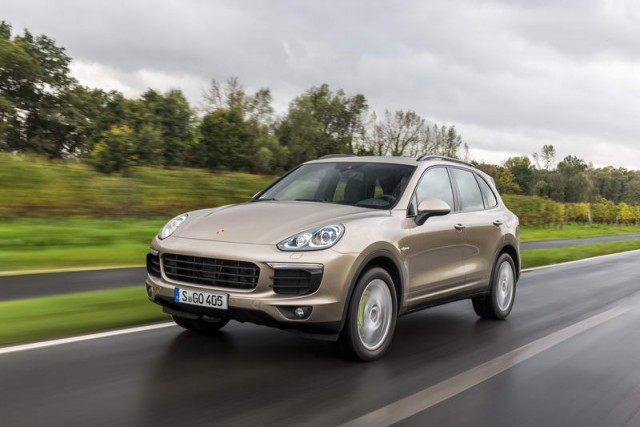Following on from the Panamera S E-Hybrid we shouldn't be too surprised that a similar drivetrain would be applied to the Cayenne SUV, but what is surprising is how well Porsche has made it work in a much larger vehicle.

In the metal
To the untrained eye there is nothing to noticeably differentiate this E-Hybrid version from the rest of the Porsche Cayenne range. There's still a quad-exhaust setup at the rear and the same overall divisive design. The only obvious features that this is a plug-in hybrid model are the provision of an additional 'fuel' flap (for the battery charging inlet), the 'acid green' brake callipers and similarly accented badging.

The bright green theme continues inside, though thankfully it is limited to the needles on the dashboard instruments, which retain the rev counter as the main, central dial - there is still a 3.0-litre supercharged V6 under that bonnet after all. To the left is a power meter that indicates how much battery power is being used or how much is being recuperated, while there are also separate battery charge and fuel level dials.

Our test cars were highly specified, which caused us to lose count of the number of buttons after 107, but as busy as the centre console may look it is still marginally better than that of the Panamera's. Throughout most of the cabin there are more than adequate levels of space for passengers though the front passenger's footwell isn't the most spacious. There is still plenty of space in the boot at 580 litres, which can be expanded to 1,690 litres.
Driving it
Every time you start the Cayenne S E-Hybrid it defaults to electric driving mode as long as there is sufficient charge in the 10.8kWh lithium-ion battery. In fact that battery pack is the same size as the one in the Panamera S E-Hybrid, but has been equipped with better-performing cells that enable the Cayenne to drive for up to 36 kilometres using only electric power.

Once this energy runs out or, as is more likely to happen, you prod the throttle with more force, the Porsche's 3.0-litre supercharged V6 spins into life to provide an additional 333hp. It provides more than enough shove to enable the Cayenne to clip along at a healthy pace whilst providing a strong engine tone as it progresses through the eight-speed automatic transmission.
As with most hybrids a certain amount of energy can be recuperated under braking, but the engine can also be used to directly re-charge the Porsche's battery. This can be done by activating the E-Charge mode and Porsche claims that it can fully replenish the battery's capacity in around 30 minutes of driving - though this will have a greater impact on the car's fuel consumption and can take a slight edge off of the engine's performance. When not being driven aggressively the transition between electrical and petrol motors is smooth, but should you suddenly need a burst of power the response is near-instant, with both motors combining to produce a system output of 416hp and 590Nm of torque.

Aside from the clever energy technologies at work, the Cayenne handles reasonably well given its size and overall weight of 2,350kg, which is around 265kg more than a standard Cayenne S. Through corners it remains composed thanks to the double wishbone setup up front and multi-link layout at the rear. The steering is responsive but still lacks the involving feedback of the other cars in Porsche's line-up.
What you get for your money
Putting it up to the argument that diesel is the best way to go the Porsche Cayenne S E-Hybrid is actually cheaper than the Cayenne Diesel to buy and if you do relatively short distances during your commute, running costs could be reduced for many people. Porsche claims that the Cayenne S E-Hybrid can return a combined 3.4 litres/100km in fuel consumption, while its emissions are just 79g/km, meaning that it falls into tax Band A1, which currently has an annual cost of €170. That's significantly less than the 173g/km rating of the Cayenne Diesel and would save €580 on road tax alone per year. Factor in the falling price of petrol and the fact that it has a 36km range using solely electric power and you may be surprised by the maths.

Worth noting
Even though a 36km electric driving range might not sound all that far, Porsche reckons that it is close to the average daily commute for typical Cayenne drivers. In addition to that, the lithium ion battery pack can be charged in around three and a half hours using a public charging point, but can be fully charged in 90 minutes from a dedicated home charging point. And as Porsche often throws its hand towards some fine pieces of industrial design, the optional branded wall-box from them is like a modern work of art by itself. This can also by controlled via a smartphone app that can adjust the car's interior temperature to your choosing while still connected to the charging point - negating the need to turn your air conditioning to full when you first get in.
Summary
The idea of a plug-in hybrid Porsche Cayenne S would have seemed like a silly exercise in environmentalist appeasement not that long ago, but Porsche has cleverly demonstrated that the technology can be applied in a way that is not only functional in real-world scenarios but doesn't have to cost a relative fortune to own in the first place.
























